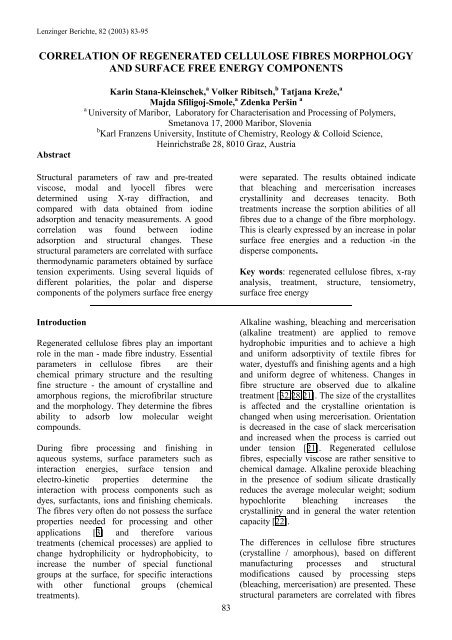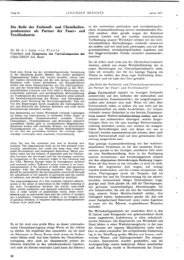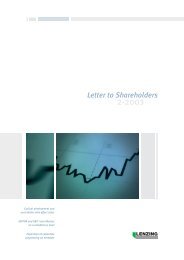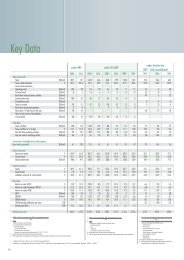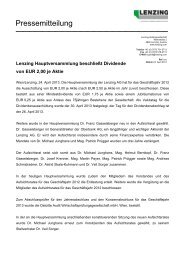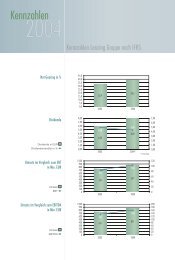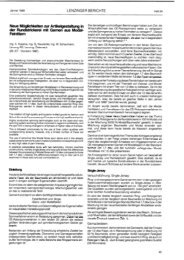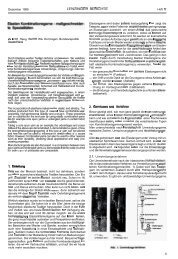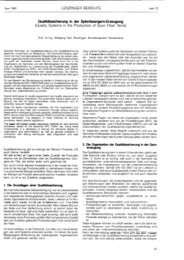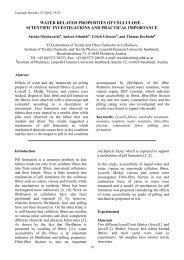Correlation of regenerated fibres morphology and surface ... - Lenzing
Correlation of regenerated fibres morphology and surface ... - Lenzing
Correlation of regenerated fibres morphology and surface ... - Lenzing
You also want an ePaper? Increase the reach of your titles
YUMPU automatically turns print PDFs into web optimized ePapers that Google loves.
<strong>Lenzing</strong>er Berichte, 82 (2003) 83-95<br />
CORRELATION OF REGENERATED CELLULOSE FIBRES MORPHOLOGY<br />
AND SURFACE FREE ENERGY COMPONENTS<br />
Abstract<br />
Karin Stana-Kleinschek, a Volker Ribitsch, b Tatjana Kreže, a<br />
Majda Sfiligoj-Smole, a Zdenka Peršin a<br />
a University <strong>of</strong> Maribor, Laboratory for Characterisation <strong>and</strong> Processing <strong>of</strong> Polymers,<br />
Smetanova 17, 2000 Maribor, Slovenia<br />
b Karl Franzens University, Institute <strong>of</strong> Chemistry, Reology & Colloid Science,<br />
Heinrichstraße 28, 8010 Graz, Austria<br />
Structural parameters <strong>of</strong> raw <strong>and</strong> pre-treated<br />
viscose, modal <strong>and</strong> lyocell <strong>fibres</strong> were<br />
determined using X-ray diffraction, <strong>and</strong><br />
compared with data obtained from iodine<br />
adsorption <strong>and</strong> tenacity measurements. A good<br />
correlation was found between iodine<br />
adsorption <strong>and</strong> structural changes. These<br />
structural parameters are correlated with <strong>surface</strong><br />
thermodynamic parameters obtained by <strong>surface</strong><br />
tension experiments. Using several liquids <strong>of</strong><br />
different polarities, the polar <strong>and</strong> disperse<br />
components <strong>of</strong> the polymers <strong>surface</strong> free energy<br />
Introduction<br />
Regenerated cellulose <strong>fibres</strong> play an important<br />
role in the man - made fibre industry. Essential<br />
parameters in cellulose <strong>fibres</strong> are their<br />
chemical primary structure <strong>and</strong> the resulting<br />
fine structure - the amount <strong>of</strong> crystalline <strong>and</strong><br />
amorphous regions, the micr<strong>of</strong>ibrilar structure<br />
<strong>and</strong> the <strong>morphology</strong>. They determine the <strong>fibres</strong><br />
ability to adsorb low molecular weight<br />
compounds.<br />
During fibre processing <strong>and</strong> finishing in<br />
aqueous systems, <strong>surface</strong> parameters such as<br />
interaction energies, <strong>surface</strong> tension <strong>and</strong><br />
electro-kinetic properties determine the<br />
interaction with process components such as<br />
dyes, surfactants, ions <strong>and</strong> finishing chemicals.<br />
The <strong>fibres</strong> very <strong>of</strong>ten do not possess the <strong>surface</strong><br />
properties needed for processing <strong>and</strong> other<br />
applications [3] <strong>and</strong> therefore various<br />
treatments (chemical processes) are applied to<br />
change hydrophilicity or hydrophobicity, to<br />
increase the number <strong>of</strong> special functional<br />
groups at the <strong>surface</strong>, for specific interactions<br />
with other functional groups (chemical<br />
treatments).<br />
83<br />
were separated. The results obtained indicate<br />
that bleaching <strong>and</strong> mercerisation increases<br />
crystallinity <strong>and</strong> decreases tenacity. Both<br />
treatments increase the sorption abilities <strong>of</strong> all<br />
<strong>fibres</strong> due to a change <strong>of</strong> the fibre <strong>morphology</strong>.<br />
This is clearly expressed by an increase in polar<br />
<strong>surface</strong> free energies <strong>and</strong> a reduction -in the<br />
disperse components.<br />
Key words: <strong>regenerated</strong> cellulose <strong>fibres</strong>, x-ray<br />
analysis, treatment, structure, tensiometry,<br />
<strong>surface</strong> free energy<br />
Alkaline washing, bleaching <strong>and</strong> mercerisation<br />
(alkaline treatment) are applied to remove<br />
hydrophobic impurities <strong>and</strong> to achieve a high<br />
<strong>and</strong> uniform adsorptivity <strong>of</strong> textile <strong>fibres</strong> for<br />
water, dyestuffs <strong>and</strong> finishing agents <strong>and</strong> a high<br />
<strong>and</strong> uniform degree <strong>of</strong> whiteness. Changes in<br />
fibre structure are observed due to alkaline<br />
treatment [32,28,21]. The size <strong>of</strong> the crystallites<br />
is affected <strong>and</strong> the crystalline orientation is<br />
changed when using mercerisation. Orientation<br />
is decreased in the case <strong>of</strong> slack mercerisation<br />
<strong>and</strong> increased when the process is carried out<br />
under tension [21]. Regenerated cellulose<br />
<strong>fibres</strong>, especially viscose are rather sensitive to<br />
chemical damage. Alkaline peroxide bleaching<br />
in the presence <strong>of</strong> sodium silicate drastically<br />
reduces the average molecular weight; sodium<br />
hypochlorite bleaching increases the<br />
crystallinity <strong>and</strong> in general the water retention<br />
capacity [22].<br />
The differences in cellulose fibre structures<br />
(crystalline / amorphous), based on different<br />
manufacturing processes <strong>and</strong> structural<br />
modifications caused by processing steps<br />
(bleaching, mercerisation) are presented. These<br />
structural parameters are correlated with <strong>fibres</strong>
<strong>Lenzing</strong>er Berichte, 82 (2003) 83-95<br />
<strong>surface</strong> tension, sorption velocity, contact angle<br />
<strong>and</strong> finally the polar <strong>and</strong> disperse part <strong>of</strong><br />
<strong>surface</strong> free energy.<br />
Structure <strong>of</strong> man made cellulose <strong>fibres</strong><br />
Man-made cellulose <strong>fibres</strong> are produced from<br />
<strong>regenerated</strong> cellulose II which is obtained in<br />
two ways, either treating native cellulose with<br />
strongly alkaline solutions or precipitation from<br />
solutions. These <strong>fibres</strong> are generally described<br />
by a fibrillar structure model [15]. Depending<br />
on the spinning conditions, differences in the<br />
structural arrangement between different types<br />
<strong>of</strong> man-made cellulose <strong>fibres</strong> [9,20,9,28] are<br />
found, for example different density, crystallite<br />
size, crystallite orientation <strong>and</strong> pore structure.<br />
Fibres spun according to the viscose process<br />
(CV) have a skin-core structure <strong>and</strong> a<br />
transverse non-uniformity.<br />
More uniform structured <strong>and</strong> spherical crosssectioned<br />
modal <strong>fibres</strong> are obtained [9] if a<br />
modified viscose process retarding the cellulose<br />
regeneration is applied. This process causes<br />
increased molecular orientation especially in<br />
the crystalline regions <strong>and</strong> higher stretching<br />
ratios compared to the conventional viscose<br />
process, leading to high tenacity <strong>fibres</strong>.<br />
NMMO or lyocell <strong>fibres</strong> (CLY), produced by<br />
the amine oxide process [9] are solvent spun<br />
<strong>and</strong> show characteristic round cross-sections<br />
<strong>and</strong> a smooth <strong>surface</strong>. Their high degree <strong>of</strong><br />
crystallinity, molecular orientation <strong>and</strong> higher<br />
molecular weight causes special properties such<br />
as high wet fibre strength <strong>and</strong> comparatively<br />
low elongation, leading to the remarkable<br />
dimensional stability <strong>of</strong> fabrics produced from<br />
them [32,9,18,23].<br />
No significant differences in the crystallite<br />
dimensions are reported, nevertheless the<br />
degree <strong>of</strong> crystallinity differs [9]. Lyocell<br />
fibre’s degree <strong>of</strong> crystallinity is 16 % higher<br />
than that <strong>of</strong> modal <strong>fibres</strong> <strong>and</strong> much higher<br />
(43%) compared to viscose <strong>fibres</strong>. The fibrils in<br />
lyocell <strong>fibres</strong> are thinner than in CMD <strong>and</strong> CV<br />
<strong>fibres</strong> <strong>and</strong> molecular orientation is nearly the<br />
same (orientation function <strong>of</strong> lyocell <strong>fibres</strong> is<br />
3% higher) as in modal <strong>fibres</strong> but much higher<br />
84<br />
compared to viscose st<strong>and</strong>ard <strong>fibres</strong> (18%).<br />
Lenz <strong>and</strong> Schurz [15] determined the size <strong>of</strong><br />
crystalline regions <strong>of</strong> <strong>regenerated</strong> cellulose<br />
<strong>fibres</strong>: length 12 - 14 nm, width 8 - 10 nm, <strong>and</strong><br />
thickness 3 - 4 nm. The broad plane <strong>of</strong> the<br />
platelet-shaped crystallites is situated parallel to<br />
the 101- lattice plane. The crystallites form<br />
str<strong>and</strong>s with a length <strong>of</strong> 150 nm - 550 nm. They<br />
are partly bundled up in clusters with diameters<br />
<strong>of</strong> 30 - 60 nm, partly separated by less dense<br />
spacing regions.<br />
Surface Tension<br />
The above discussed crystallites size,<br />
orientation <strong>and</strong> distribution as well as the<br />
presence <strong>and</strong> size <strong>of</strong> amorphous regions <strong>and</strong><br />
voids (void volume, inner <strong>surface</strong>) [19] are the<br />
parameters that determine the <strong>fibres</strong> adsorption<br />
<strong>and</strong> interaction abilities.<br />
Polar <strong>and</strong> non-polar groups cause fibre’s<br />
hydrophobic <strong>and</strong> hydrophilic nature obtained<br />
by various treatments. A lack <strong>of</strong> hydrophilicity<br />
is either due to the absence <strong>of</strong> polar groups or<br />
due to their non-accessible locations. The<br />
degree <strong>of</strong> hydrophilicity or wetting <strong>of</strong> a nonporous<br />
solid by a liquid is observed in two<br />
ways, either measuring the contact angle θ<br />
directly using goniometry or calculating it from<br />
data obtained by tensiometry.<br />
From the known contact angle or the help <strong>of</strong><br />
indirect methods [3,39] the <strong>surface</strong> energy <strong>of</strong><br />
solid can be determined [3,25,27,36,40] <strong>and</strong><br />
separated into a polar <strong>and</strong> a disperse part,<br />
according to the following considerations: If a<br />
liquid <strong>and</strong> a solid <strong>surface</strong> come in contact, an<br />
interaction between the polar parts as well as<br />
the disperse parts <strong>of</strong> both phases will take place<br />
at the interphase, but not between the polar <strong>and</strong><br />
the disperse parts [14]. The interfacial tension<br />
<strong>of</strong> the two phases in contact is always lower<br />
than the total <strong>surface</strong> tension <strong>of</strong> separate phases<br />
due to interactions at the interphase. If one <strong>of</strong><br />
the two phases in contact is non-polar, only<br />
dispersion interactions are possible. While<br />
dispersion forces exist in all molecules, the<br />
polar forces only exist in special molecules.<br />
They arise from the difference in electro<br />
negativity between different atoms in the same
<strong>Lenzing</strong>er Berichte, 82 (2003) 83-95<br />
molecule [14]. Therefore one can determine the<br />
polar <strong>and</strong> disperse part <strong>of</strong> the <strong>surface</strong> free<br />
energy measuring the contact angle between a<br />
solid <strong>and</strong> several liquids <strong>of</strong> different polarity<br />
[14,27].<br />
Material <strong>and</strong> methods<br />
Fibres <strong>and</strong> <strong>fibres</strong> treatment processes<br />
One solvent spun cellulose fibre (<strong>Lenzing</strong><br />
Lyocell - CLY) <strong>and</strong> two conventional cellulose<br />
<strong>fibres</strong> made by the viscose process (<strong>Lenzing</strong><br />
Viscose CV <strong>and</strong> <strong>Lenzing</strong> Modal CMD) were<br />
investigated <strong>and</strong> are summarized in Table 1.<br />
The <strong>fibres</strong> were treated using a Turbomat Ahiba<br />
laboratory dyeing apparatus according to the<br />
processes conventionally used in textile praxis<br />
(Table 2). The alkaline treatment was<br />
performed without any tension on the <strong>fibres</strong><br />
(usually called slack mercerisation); we will<br />
refer to it as “mercerisation”.<br />
Fibre type Viscose Modal Lyocell<br />
Symbol CV CMD CLY<br />
Linear density 1.88 1.78 1.82<br />
Tt [dtex] ±0.15 ±0.23 ±0.3<br />
Fibre length 39.9 40.1 39.4<br />
l [mm]<br />
±0.51 ±0.33 ±0.44<br />
Fibre diameter 14.3 14.2 12.8<br />
d [µm]<br />
±1.39 ±1.10 ±1.00<br />
Density 1.5045 1.5141 1.5205<br />
ρ [g/cm 3 ]<br />
Degree <strong>of</strong> polymerisation<br />
DPη<br />
Molecular<br />
mass Mη<br />
235<br />
±5.13<br />
38.000<br />
±880<br />
507<br />
±3.61<br />
82.100<br />
±540<br />
642<br />
±4.58<br />
104.000<br />
±730<br />
Table 1. The specifications <strong>of</strong> investigated <strong>regenerated</strong><br />
cellulose <strong>fibres</strong><br />
X-Ray analysis<br />
The influence <strong>of</strong> different treatment processes,<br />
e.g. bleaching <strong>and</strong> slack mercerising (alkaline<br />
treatment), on the structural changes in<br />
different types <strong>of</strong> <strong>regenerated</strong> cellulose <strong>fibres</strong><br />
was investigated by means <strong>of</strong> x-ray analysis,<br />
the procedure is described in detail in several<br />
references [24,1,6,2,29,34,35]. Ni filtered<br />
copper radiation from a conventional x-ray tube<br />
85<br />
(50 kV / 45 mA) was used in all scattering<br />
experiments.<br />
Bleaching Alkaline treatment<br />
6 ml/l H2O2 40 g/l NaOH<br />
2 ml/l Tanatex Geo 7 ml/l Tanawet BC<br />
(mineral stabilizer for (wetting agent,<br />
H2O2 stabilization) anionic)<br />
pH = 10.7 pH = 12.8<br />
t = 30 min t = 1 min<br />
T = 98° C T = 10°C<br />
Table 2. Conditions <strong>of</strong> the treatment processes -<br />
bleaching <strong>and</strong> slack mercerisation (alkaline treatment<br />
without tension)<br />
Determination <strong>of</strong> the long spacing by small<br />
angle x-ray scattering (SAXS). SAXS intensity<br />
curves were measured using a Kratky camera<br />
with a slit collimation using a PSD position<br />
sensitive detector counting scattered intensity in<br />
the meridional direction, i.e. parallel to the fibre<br />
axis. The experimental data was corrected for<br />
absorption <strong>and</strong> background scattering <strong>and</strong> long<br />
spacing was determined applying Bragg’s law:<br />
n.λ<br />
L = (1)<br />
2.sinθ<br />
where L is the long spacing, n order <strong>of</strong><br />
reflection, λ wavelength <strong>of</strong> x-rays <strong>and</strong> θ<br />
Bragg’s scattering angle.<br />
Determination <strong>of</strong> the crystallinity index <strong>and</strong><br />
crystalline orientation by wide-angle x-ray<br />
scattering (WAXS). A two-circle goniometer<br />
equipped with a linear position sensitive<br />
detector (PSD was used to measure the twodimensional<br />
WAXS scattering diagrams<br />
(azimuthal angular range from 0° to 180° in<br />
steps <strong>of</strong> 5°). The full pattern after the<br />
subtraction <strong>of</strong> the background scattering <strong>and</strong> the<br />
absorption <strong>and</strong> some steps <strong>of</strong> the evaluating<br />
procedure for one <strong>of</strong> the analysed <strong>fibres</strong> are<br />
presented in Figure 1.<br />
A weighted integration <strong>of</strong> the two dimensional<br />
diagram (Eq.2) was performed to obtain a<br />
„r<strong>and</strong>omized“ scattering I(2θ) curve, which was<br />
corrected for Compton scattering.
<strong>Lenzing</strong>er Berichte, 82 (2003) 83-95<br />
scattering<br />
angle<br />
I(a.u.)<br />
Azimuthal<br />
angle<br />
I(a.u.) 2θ<br />
Figure 1. The full pattern for an analysed fibre,<br />
r<strong>and</strong>omised curve <strong>and</strong> the separation <strong>of</strong> the crystalline<br />
<strong>and</strong> amorphous scattering<br />
∫ I(2θ( ϕ )sin( ϕ )dϕ<br />
I (2θ ) =<br />
(2)<br />
∫ sin( ϕ )dϕ<br />
The amorphous contribution was approximated<br />
by a polynomial approximation <strong>and</strong> the curves<br />
were than analysed for crystallinity. The degree<br />
<strong>of</strong> crystallinity xcr was estimated by the ratio <strong>of</strong><br />
the crystalline scattering versus total scattering<br />
(Eq.3) [1,6]:<br />
2θ<br />
86<br />
xcr =<br />
2θ2<br />
∫<br />
c<br />
2θ1<br />
2θ2<br />
∫<br />
2θ1<br />
I ( θ ). dθ<br />
I(<br />
θ ) . dθ<br />
(3)<br />
where I is the entire coherently scattered<br />
intensity, Ic is the coherent intensity in the<br />
crystalline peaks <strong>and</strong> 2θ = diffraction angle.<br />
The orientation parameter fc was determined<br />
through the integral azimuthal distributionwidth<br />
<strong>of</strong> the 101 reflections <strong>and</strong> Hermans’<br />
orientation function fc was calculated according<br />
to:<br />
2<br />
3. cos ϕ − 1<br />
fc =<br />
(4)<br />
2<br />
where ϕ is the angle between the c<br />
crystallographic axis <strong>and</strong> the fibre axis.<br />
A strong interference <strong>of</strong> (101) <strong>and</strong> (021)<br />
crystalline reflection existed, therefore, an<br />
approximation using Gauss <strong>and</strong> Lorentz<br />
distribution was carried out to separate the two<br />
maxima as shown in Figure 2, <strong>and</strong><br />
determination <strong>of</strong> the azimuthal intensity<br />
distribution <strong>of</strong> (101) reflections followed.<br />
I(a.u.)<br />
Figure 2. Approximation <strong>of</strong> the (101) <strong>and</strong> (021)<br />
crystalline reflections by Gauss <strong>and</strong> Lorentz distribution<br />
after the subtraction <strong>of</strong> amorphous background<br />
Iodine sorption<br />
The Schwertassek method was used for<br />
determining iodine-sorption [31,28]. The <strong>fibres</strong><br />
were first treated with KJ3 solution <strong>and</strong><br />
afterwards the concentration <strong>of</strong> non-absorbed<br />
iodine was determined by titration. Iodine<br />
sorption value ISV is the amount <strong>of</strong> iodine<br />
adsorbed by one gram <strong>of</strong> cellulose substrate. It<br />
is calculate in the following way:<br />
2θ
<strong>Lenzing</strong>er Berichte, 82 (2003) 83-95<br />
( a − b ⋅1,<br />
33)<br />
⋅ F ⋅ 2,<br />
538<br />
ISV = (5)<br />
ma<br />
where a is volume [ml] <strong>of</strong> Na2S2O3 solution (c<br />
= 0.01 mol/l) for aliquot <strong>of</strong> blank KI solution, b<br />
is volume [ml] <strong>of</strong> Na2S2O3 solution (c = 0.01<br />
mol/l) for aliquot <strong>of</strong> sample solution, c is<br />
constant (for cellulose: 1.33), F is aliquot factor<br />
<strong>of</strong> Na2S2O3 solution, determined by KMnO4<br />
(0.02 mol/l) <strong>and</strong> ma is weight <strong>of</strong> absolutely dry<br />
fibre sample [g].<br />
Mechanical properties<br />
Stress-strain curves were measured using a<br />
Vibrodyn 400 dynamometer (<strong>Lenzing</strong> Technik<br />
Instruments) with a length between the clamps<br />
<strong>of</strong> 20 mm according to ISO 2062, linear density<br />
was determined using a Vibroskop 400<br />
(<strong>Lenzing</strong> Technik Instruments). Testing<br />
conditions were T = 20ºC, Rh = 65%, the<br />
presented data are averages from 10<br />
experiments.<br />
Sorption measurements<br />
Sorption measurements were carried out with<br />
<strong>fibres</strong> (raw <strong>and</strong> treated) placed in a cylindrical<br />
cell coming in contact with fluids <strong>of</strong> different<br />
polarity. The mass increase as a function <strong>of</strong><br />
time (capillary velocity in a fibre plug) was<br />
monitored as described in earlier publications<br />
[4]. The results presented are statistically<br />
processed average values <strong>of</strong> 10 parallel<br />
measurements. The liquids (water, ethylene<br />
glycol, formamide, ethanol, <strong>and</strong> n-heptane)<br />
used in the sorption experiments (tensiometry)<br />
were chosen because <strong>of</strong> their specific polarities<br />
[12] which are appropriate to calculate contact<br />
angles <strong>and</strong> solid’s <strong>surface</strong> energies from<br />
measured capillary velocities. A Krüss<br />
Tensiometer K12 GmbH Hamburg was used for<br />
these gravimetric measurements.<br />
Calculation <strong>of</strong> contact angle <strong>and</strong> <strong>surface</strong> free<br />
energy. The modified Washburn Equation 1<br />
[26,28,38] allows to calculate the contact angle<br />
θ from measured sorption velocities:<br />
2<br />
mass η<br />
cos θ = ⋅<br />
. (6)<br />
2 t ρ ⋅γ<br />
⋅c<br />
87<br />
1<br />
c ⋅<br />
2<br />
2 2 2<br />
= ⋅π<br />
⋅ r nk<br />
. (7)<br />
where mass 2 /t represents the sorption velocity<br />
(g 2 /s), η is liquid ’ s viscosity (mPa.s), ρ is<br />
liquid’s density (g/cm 3 ), γ is the liquid’s <strong>surface</strong><br />
tension (mN/m), θ is contact angle between<br />
solid <strong>and</strong> liquid phase ( o ), c is material constant<br />
or c factor, r is the capillary radius (m), <strong>and</strong> nk<br />
is number <strong>of</strong> capillaries.<br />
The fibre’s <strong>surface</strong> energy (γs) was determined<br />
indirectly - from the contact angle data.<br />
According to Young’s Equation (3), the <strong>surface</strong><br />
energy <strong>of</strong> a solid is given as [13]:<br />
γ s −γ SL = γ L ⋅cosθ<br />
(8)<br />
where γ represents <strong>surface</strong> tension <strong>of</strong> the solid<br />
(s) (mNm -1 ), SL the solid-liquid interface, L the<br />
liquid <strong>and</strong> θ ( o ) is the contact angle between the<br />
solid <strong>and</strong> liquid phase.<br />
Fowkes [7] proposed that the <strong>surface</strong> energy <strong>of</strong><br />
a liquid or a solid could be separated into a<br />
disperse <strong>and</strong> a polar component:<br />
γ = γ + γ<br />
s<br />
d<br />
s<br />
p<br />
s<br />
γ = γ + γ (9, 10)<br />
l<br />
where γ represents the <strong>surface</strong> energies (mJm -2 )<br />
<strong>of</strong> the solid (s), <strong>and</strong> liquid (l) with the disperse<br />
part (d) <strong>and</strong> the polar part (p). The interfacial<br />
energy <strong>of</strong> liquids <strong>and</strong> solids with both disperse<br />
<strong>and</strong> polar components are described as [13]:<br />
SL<br />
S<br />
L<br />
d<br />
l<br />
p<br />
l<br />
γ = γ + γ − 2 γ γ − 2<br />
d<br />
s<br />
d<br />
L<br />
p p<br />
γ s γ L<br />
(11)<br />
Introduction <strong>of</strong> the work <strong>of</strong> adhesion [36] <strong>and</strong><br />
conversion leads to an equation <strong>of</strong> the type:<br />
y = mx + b<br />
1 + cos θ<br />
2<br />
γ L<br />
d<br />
γ L<br />
=<br />
p<br />
γ s ∗<br />
p<br />
γ L<br />
+ d<br />
γ L<br />
d<br />
γ s<br />
(12)<br />
d<br />
p<br />
The valuesγ l , γ l <strong>and</strong> γ l are known material<br />
constants <strong>and</strong> the values <strong>of</strong> x <strong>and</strong> y can be<br />
determined. From the linear fit <strong>of</strong> the plot y<br />
versus x one gets the polar (Equation 13) <strong>and</strong><br />
disperse (Equation 14) component <strong>of</strong> <strong>surface</strong><br />
free energy [14,30]:
<strong>Lenzing</strong>er Berichte, 82 (2003) 83-95<br />
p 2<br />
γ m (13)<br />
s =<br />
d 2<br />
γ b (14)<br />
s =<br />
Results <strong>and</strong> discussion<br />
X-Ray analysis<br />
Small angle X-ray scattering SAXS. All types <strong>of</strong><br />
<strong>regenerated</strong> cellulose <strong>fibres</strong> exhibit a welldefined<br />
maximum on the meridional SAXS<br />
diagram (Figure 3) indicating periodical<br />
structures due to alternation <strong>of</strong> crystalline <strong>and</strong><br />
amorphous regions along the fibre axis. The<br />
long period values were calculated (Table 3)<br />
2θ 2 .I(2θ) 2θ 2 .I(2θ) 2θ 2 .I(2θ)<br />
88<br />
from the peak position <strong>and</strong> are almost similar<br />
for all untreated <strong>fibres</strong> (approx. 13.5 nm). This<br />
This This finding is in good agreement with the<br />
values reported [8,17]. Fibre’s treatment in<br />
alkaline solution or a bleaching medium causes<br />
distinct changes. In the case <strong>of</strong> viscose <strong>fibres</strong> an<br />
increase <strong>of</strong> the long spacing for about 15%<br />
occurs regardless <strong>of</strong> the treatment conditions<br />
applied. Modal <strong>fibres</strong> show a significant change<br />
<strong>of</strong> long spacing (by about 15%) only in case <strong>of</strong><br />
alkaline treatment. The opposite effect was<br />
observed with lyocell <strong>fibres</strong> showing a decrease<br />
<strong>of</strong> long spacing <strong>of</strong> about 10% (bleaching) <strong>and</strong><br />
5% (mercerisation).<br />
2θ 2θ 2θ<br />
Figure 3. Plot <strong>of</strong> 2θ 2 . I(2θ) vs. 2θ <strong>of</strong> meridional SAXS curve for the untreated viscose, modal <strong>and</strong> lyocell <strong>fibres</strong>,<br />
respectively.<br />
Viscose <strong>fibres</strong> are <strong>of</strong> low crystallinity but<br />
highly accessible to different media due to their<br />
mainly amorphous molecular arrangement <strong>and</strong><br />
an extensive inner <strong>surface</strong>. This <strong>morphology</strong><br />
enables a better sorption <strong>of</strong> water <strong>and</strong> low<br />
molecular species, compared to the two other<br />
<strong>fibres</strong> [11,28] causing major structural<br />
reorganization shown by the changes in long<br />
spacing.<br />
Cellulose molecules in CMD <strong>fibres</strong> are well<br />
oriented, have a higher degree <strong>of</strong><br />
polymerisation <strong>and</strong> are densely packed. A nonextensive<br />
void system is formed because <strong>of</strong> the<br />
spinning process at high drawing ratios [9].<br />
This structural parameter is the reason for the<br />
lower hydrophilic capacity <strong>of</strong> modal <strong>fibres</strong> in<br />
comparison to viscose or lyocell <strong>fibres</strong>.<br />
Mercerisation is the only treatment process that<br />
causes significantly increased long spacing <strong>and</strong><br />
promotes the swelling process.<br />
Lyocell <strong>fibres</strong> have a more complicated<br />
structure. They show high hydrophilicity<br />
caused by the <strong>fibres</strong> larger void system<br />
(comparable with viscose) <strong>and</strong> not by the<br />
fibre’s superstructure. It was shown that water<br />
swollen solvent spun <strong>fibres</strong> contain more<br />
separated elementary fibrils <strong>and</strong> less nonswelling<br />
clusters than <strong>fibres</strong> spun from<br />
cellulose derivates [17]. The interstices that<br />
separate single elementary fibrils, the<br />
interfibrillar <strong>and</strong> intrafibrillar voids are<br />
accessible to water, sodium hydroxide <strong>and</strong><br />
other treating media. The dense fibre inner<br />
structure prevents major structural<br />
reorganization if the lyocell <strong>fibres</strong> are bleached<br />
or mercerised without tension. Swelling does<br />
not create new voids nor do existing voids<br />
disappear; only the voids diameter is increased<br />
[16]. In the case <strong>of</strong> viscose <strong>and</strong> modal <strong>fibres</strong> the<br />
increase <strong>of</strong> long spacing is accompanied by a<br />
more pronounced crystallinity increase that<br />
could additionally influence changes in the<br />
periodical structure.
<strong>Lenzing</strong>er Berichte, 82 (2003) 83-95<br />
Fibre Treatment Long<br />
period<br />
nm<br />
Crystalli-nity<br />
index<br />
xfc<br />
Orientation<br />
function<br />
89<br />
fc<br />
*Voids<br />
volume<br />
cm 3 /g<br />
*Voids<br />
diameter<br />
nm<br />
*Inner<br />
<strong>surface</strong><br />
m²/g<br />
Tenacity<br />
cN/tex<br />
Viscose untreated 13.5 0.25 0.580 0.68 3.1 439 22.0<br />
bleaching 15.5 0.25 0.494 20.0<br />
mercerisation 15.6 0.38 0.722 19.5<br />
Modal untreated 13,5 0.37 0.706 0.49 2.4 409 34.0<br />
bleaching 13.7 0.44 0.583 32.0<br />
mercerisation 15.5 0.57 0.561 30.5<br />
Lyocell untreated 13.8 0.44 0.664 0.62 3.0 432 33.0<br />
bleaching 12.3 0.46 0.677 34.5<br />
mercerisation 13.0 0.50 0.768 27.0<br />
Table 3. Long periods, crystallinity index, Herman’s orientation function, *voids volume, diameter <strong>and</strong> inner <strong>surface</strong> <strong>of</strong><br />
voids (determined using Size Exclusion Chromatography) <strong>and</strong> tenacity <strong>of</strong> untreated <strong>and</strong> treated <strong>fibres</strong><br />
Wide angle X-ray scattering WAXS. All<br />
analysed <strong>fibres</strong> show intensive scattering with<br />
negligible differences between the solvent spun<br />
<strong>and</strong> the two other fibre types. Fibre treatment<br />
always causes separation <strong>of</strong> the scattering<br />
function’s peaks. The obtained results are<br />
presented in Table 3, one example <strong>of</strong> the<br />
r<strong>and</strong>omised scattering curves <strong>of</strong> viscose is<br />
shown in Figure 5.<br />
Crystallinity index. The crystallinity index<br />
(Figure 6) <strong>of</strong> viscose <strong>and</strong> modal <strong>fibres</strong> differ as<br />
expected, viscose has a lower crystallinity<br />
(0.25) than modal (0.37), lyocell <strong>fibres</strong> have the<br />
highest crystallinity index <strong>of</strong> 0.44. Any kind <strong>of</strong><br />
treatment significantly increases the<br />
crystallinity index, which agrees very well with<br />
those results given in the literature [15].<br />
Lyocell <strong>fibres</strong> are more stable than viscose or<br />
modal <strong>fibres</strong> in alkaline medium <strong>and</strong> therefore<br />
crystallinity increase is more pronounced for<br />
derivate spun cellulose <strong>fibres</strong> in comparison to<br />
solvent spun <strong>fibres</strong>. Viscose <strong>fibres</strong> crystallinity<br />
index is strongly dependent on the treatment<br />
conditions with an almost negligible increase<br />
caused by bleaching <strong>and</strong> a large increase caused<br />
by mercerisation (52%).<br />
The bleaching <strong>of</strong> viscose <strong>fibres</strong> may cause<br />
some oxidative damage <strong>and</strong> therefore a limited<br />
increase <strong>of</strong> crystallinity, nevertheless, it causes<br />
a significant increase <strong>of</strong> long spacing.<br />
A more pronounced crystallinity increase is<br />
observed after the bleaching <strong>of</strong> CMD (19%)<br />
<strong>and</strong> a strong one (53%) after alkaline treatment.<br />
Longer cellulose molecules in CMD <strong>fibres</strong> are<br />
less sensitive <strong>and</strong> more resistant to oxidative<br />
damages <strong>and</strong> therefore the influence <strong>of</strong> the<br />
alkaline environment predominates <strong>and</strong> an<br />
increase <strong>of</strong> crystallinity is observed.<br />
The large degree <strong>of</strong> polymerisation <strong>of</strong> about<br />
640 <strong>and</strong> the more complex structure are the<br />
reasons why lyocell <strong>fibres</strong> are more stable<br />
under any <strong>of</strong> the treatment conditions. A<br />
comparable small increase <strong>of</strong> crystallinity index<br />
occurs, however, <strong>and</strong> a correlation between the<br />
pH value <strong>of</strong> the treating medium <strong>and</strong> the<br />
crystallinity increase can be assumed. The pH<br />
value at bleaching is 10.7 <strong>and</strong> at mercerisation<br />
12.8, the increases <strong>of</strong> crystallinity 5% <strong>and</strong> 14%,<br />
respectively.<br />
Iodine sorption data confirms the X-ray results<br />
<strong>of</strong> crystallinity changes (Figure 7) especially<br />
when chemical changes caused by the oxidative<br />
bleaching process are taken into account. The<br />
lower the ISV the higher is the degree <strong>of</strong><br />
crystallinity. This data also show that there are<br />
only very small differences in lyocells<br />
crystallinity caused by both treatments.<br />
However, the degree <strong>of</strong> cellulose products<br />
oxidation influences the iodine sorption.<br />
Crystalline orientation. Fibres reactivity <strong>and</strong><br />
accessibility as well as tensile properties are<br />
mainly influenced by crystalline orientation.<br />
This parameter shows such different trends for<br />
each fibre type, that no unique model for its<br />
explanation could be established. Warwicker
<strong>Lenzing</strong>er Berichte, 82 (2003) 83-95<br />
[37] has reported that the extent <strong>of</strong> crystallites<br />
disorientation in cotton depends on the extent<br />
<strong>of</strong> swelling <strong>and</strong> this may also be true for<br />
<strong>regenerated</strong> cellulose <strong>fibres</strong><br />
Figure 5. R<strong>and</strong>omised scattering curves with amorphous<br />
scattering for untreated, bleached <strong>and</strong> mercerised viscose<br />
<strong>fibres</strong><br />
crystallinity index<br />
0.6<br />
0.4<br />
0.2<br />
0.0<br />
Viscose Modal Lyocell<br />
untreated bleached mercerised<br />
Figure 6. Crystallinity index <strong>of</strong> untreated <strong>and</strong> pre-treated<br />
<strong>regenerated</strong> cellulose <strong>fibres</strong><br />
90<br />
ISV<br />
140<br />
120<br />
100<br />
80<br />
60<br />
40<br />
20<br />
0<br />
Viscose Modal Lyocell<br />
untreated bleached slack mercerised<br />
Figure 7. Iodine sorption value <strong>of</strong> untreated <strong>and</strong> pretreated<br />
<strong>regenerated</strong> cellulose <strong>fibres</strong><br />
. The results <strong>of</strong> crystalline orientation for<br />
treated <strong>regenerated</strong> cellulose <strong>fibres</strong> are<br />
presented in Figure 8.<br />
Crystalline orientation<br />
0.8<br />
0.7<br />
0.6<br />
0.5<br />
0.4<br />
0.3<br />
0.2<br />
0.1<br />
0.0<br />
Viscose Modal Lyocell<br />
untreated bleached mercerised<br />
Figure 8. Crystalline orientation <strong>of</strong> untreated <strong>and</strong> pretreated<br />
<strong>regenerated</strong> cellulose <strong>fibres</strong><br />
Different degrees <strong>of</strong> crystallites orientations <strong>of</strong><br />
untreated <strong>fibres</strong> were expected <strong>and</strong> finally<br />
observed because it is conditioned by the<br />
differences in production processes. The<br />
orientation increases from CV to CLY <strong>and</strong><br />
CMD. This does not correlate with earlier<br />
results, where CLY showed the highest degree<br />
<strong>of</strong> orientation [33], but it correlates well with<br />
the tensile strength reported here <strong>and</strong> explains<br />
the high tensile strengths <strong>of</strong> CMD <strong>and</strong> CLY<br />
<strong>fibres</strong> (Figure 9). Disorientation due to<br />
molecular relaxation is observed with viscose<br />
<strong>and</strong> especially modal <strong>fibres</strong> in the case <strong>of</strong> the<br />
bleaching process <strong>and</strong> happens also by the<br />
mercerisation <strong>of</strong> CMD. The increase <strong>of</strong> viscose<br />
<strong>fibres</strong> orientation due to mercerisation may be
<strong>Lenzing</strong>er Berichte, 82 (2003) 83-95<br />
promoted by high internal swelling under<br />
strong alkaline conditions in the treatment. It is<br />
connected with the penetration <strong>of</strong> the medium<br />
into the crystalline structures <strong>and</strong>, thereby, the<br />
crystalline reflections are extended. The same<br />
phenomenon is observed with lyocell <strong>fibres</strong> due<br />
to their high hydrophilicity, but to a lower<br />
extent because <strong>of</strong> lyocell fibre’s more stable<br />
structure.<br />
The changes in <strong>fibres</strong> tensile strength also<br />
correlate with crystallinity index <strong>and</strong><br />
crystallites orientation. It is presumed that<br />
changes in the crystalline structure are also<br />
accompanied by changes in the amorphous<br />
domains. One explanation <strong>of</strong> our findings may<br />
be that the increasing crystallinity reduces the<br />
number <strong>of</strong> polymers str<strong>and</strong>s in the amorphous<br />
area <strong>and</strong> this may be the reason <strong>of</strong> the<br />
decreased strength. The chemical influence<br />
(depolymerisation) under the treatment<br />
conditions will be an additional reason for the<br />
changed mechanical properties (Figure 11).<br />
Tenacity (cN/tex)<br />
35<br />
30<br />
25<br />
20<br />
15<br />
10<br />
5<br />
0<br />
Viscose Modal Lyocell<br />
untreated bleached mercerised<br />
Figure 9. Mechanical properties <strong>of</strong> untreated <strong>and</strong> pretreated<br />
<strong>regenerated</strong> cellulose <strong>fibres</strong><br />
Sorption measurements<br />
Sorption velocity was measured using the fibre<br />
plug method <strong>and</strong> contact angles were calculated<br />
from these results. Figure 10 <strong>and</strong> Table 4<br />
present the water sorption velocities <strong>of</strong> raw <strong>and</strong><br />
mercerised viscose, modal, <strong>and</strong> lyocell <strong>fibres</strong>.<br />
The observed sorption velocities show distinct<br />
differences between raw <strong>and</strong> mercerised <strong>fibres</strong>.<br />
Among raw <strong>fibres</strong>, viscose <strong>fibres</strong> have the<br />
fastest sorption velocity, even if the sorption<br />
91<br />
velocity <strong>of</strong> modal <strong>fibres</strong> is the highest at the<br />
very beginning.<br />
mass 2 (g 2 )<br />
7<br />
6<br />
5<br />
4<br />
3<br />
2<br />
1<br />
0<br />
0 10 20 30 40 50 60 t (s) 70<br />
washed slack-merc. viscose<br />
washed slack-merc. modal<br />
washed slack-merc. lyocell<br />
raw viscose<br />
raw modal<br />
raw lyocell<br />
Figure 10. Water sorption velocities <strong>of</strong> raw <strong>and</strong><br />
mercerised viscose, modal, <strong>and</strong> lyocell <strong>fibres</strong>.<br />
CV adsorbs the greatest amount <strong>of</strong> water (133%<br />
<strong>of</strong> the <strong>fibres</strong> mass) due to the large amorphous<br />
regions <strong>and</strong> predominantly void systems. Raw<br />
modal <strong>fibres</strong> have the smallest sorption ability<br />
<strong>and</strong> a sorption velocity differing from the usual<br />
quadratic increase. It is very fast <strong>and</strong> non-linear<br />
at the beginning <strong>and</strong> approaches a linear<br />
increase before saturation. Calculated from that<br />
linear range it is found to be 2.2 times slower as<br />
compared to raw viscose <strong>fibres</strong>. Raw modal<br />
<strong>fibres</strong> adsorb the smallest amount (64%) <strong>of</strong><br />
water because <strong>of</strong> their higher crystallinity<br />
index, better-orientated macromolecules <strong>and</strong><br />
the smallest void system [11]. The diameter,<br />
volume <strong>and</strong> inner <strong>surface</strong> <strong>of</strong> the lyocell fibre’s<br />
voids are similar to those <strong>of</strong> viscose [9], <strong>and</strong> so<br />
are the sorption characteristics. Raw lyocell<br />
<strong>fibres</strong> adsorb water 1.5 times slower, compared<br />
to viscose <strong>and</strong> 1.1 times faster compared to<br />
modal <strong>fibres</strong>. After water uptake their weight<br />
increases by 88 %.<br />
The sorption abilities <strong>of</strong> all <strong>fibres</strong> are increased<br />
after mercerisation. The sorption velocity<br />
becomes almost identical although the amount<br />
<strong>of</strong> adsorbed water differs clearly. The<br />
mercerised viscose <strong>fibres</strong> are able to adsorb the<br />
greatest amount <strong>of</strong> water (177 %) at a 2.6 times<br />
higher speed then raw <strong>fibres</strong>. The adsorption<br />
speed <strong>of</strong> mercerised modal <strong>fibres</strong> is also<br />
increased; nevertheless they adsorb the smallest<br />
amount <strong>and</strong> show the smallest increase after<br />
treatment. Again, the reason for these<br />
differences is based on their structural <strong>and</strong>
<strong>Lenzing</strong>er Berichte, 82 (2003) 83-95<br />
morphological characteristics, the increased<br />
degree <strong>of</strong> crystallinity, high degree <strong>of</strong><br />
polymerisation <strong>and</strong> molecular orientation <strong>and</strong><br />
the smallest void system.<br />
Fibre<br />
Sorption<br />
velocity ∗<br />
(g 2 /s)<br />
Contact<br />
angle<br />
( o )<br />
p<br />
γ s<br />
(mJ/m 2 )<br />
d<br />
γ s<br />
(mJ/m 2 )<br />
Raw viscose 0.089 80.66 25.54 8.24<br />
STDEV 1.6E-03 1.16 0.28 0.25<br />
Mer. viscose 0.175 69.26 39.95 5.46<br />
STDEV 5.0E-04 0.89 3.16 3.13<br />
Raw modal 0.052 82.38 25.01 7.99<br />
STDEV 1.0E-04 2.36 3.40 3.13<br />
Merc. modal 0.150 72.92 35.43 5.26<br />
STDEV 1E-04 1.69 3.11 2.93<br />
Raw lyocell 0.063 81.06 25.36 8.03<br />
STDEV 9.5E-05 2.87 3.34 3.11<br />
Merc. lyocell 0.157 71.52 36.69 5.41<br />
STDEV 1.0E-04 1.29 3.16 2.96<br />
Table 4. Sorption velocities, contact angles, polar <strong>and</strong><br />
disperse components <strong>of</strong> the SFE <strong>of</strong> the raw <strong>and</strong> washed<br />
slack-mercerised viscose, modal <strong>and</strong> lyocell <strong>fibres</strong>.<br />
∗ -calculated in the linear part <strong>of</strong> the slope<br />
Due to the inner <strong>surface</strong>, diameter, <strong>and</strong> volume<br />
<strong>of</strong> the mercerised lyocell fibre’s voids, they are<br />
able to adsorb more water then CMD <strong>fibres</strong>,<br />
beside the fact that they have the most<br />
crystalline structure [11]. In comparison to raw<br />
<strong>fibres</strong>, the mercerised lyocell <strong>fibres</strong> have a 5<br />
times higher sorption velocity <strong>and</strong> after water<br />
absorption their weight increases by 133 %.<br />
Comparing all three types <strong>of</strong> <strong>fibres</strong>,<br />
mercerisation caused an increase <strong>of</strong> absorption<br />
speed <strong>and</strong> amount <strong>and</strong> reduced the time needed<br />
to complete fibre wetting. The adsorption speed<br />
is almost identical; this correlates with the fact,<br />
that mercerisation reduces the differences in<br />
crystallinity index <strong>and</strong> crystalline orientation.<br />
The amount <strong>of</strong> adsorbed water correlates with<br />
the voids systems volume.<br />
Contact angles<br />
Contact angles were determined from the<br />
measured sorption velocities <strong>and</strong> using the<br />
modified Washburn Equation 1 [4]. The values<br />
<strong>of</strong> the contact angles define the wetting<br />
behaviour <strong>of</strong> the measured <strong>fibres</strong> (Figure 11,<br />
Table 4). Results are presented as average value<br />
<strong>of</strong> 10 parallel measurements.<br />
92<br />
Contact angle (°)<br />
85<br />
80<br />
75<br />
70<br />
65<br />
raw bleached washed /<br />
bleached<br />
viscose modal lyocell<br />
washed / slackmercerised<br />
Figure 11. Water contact angles <strong>of</strong> raw <strong>and</strong> treated<br />
viscose, modal, <strong>and</strong> lyocell <strong>fibres</strong> as affected by the<br />
applied treatment.<br />
Viscose <strong>fibres</strong> have the lowest degree <strong>of</strong><br />
polymerisation, the lowest degree <strong>of</strong><br />
crystallinity [9], <strong>and</strong> a large amount <strong>of</strong><br />
amorphous regions [11,9], therefore showing<br />
the best wetting <strong>and</strong> sorption properties. Modal<br />
<strong>fibres</strong> have the smallest sorption ability because<br />
<strong>of</strong> a higher degree <strong>of</strong> crystallinity <strong>and</strong> crystallite<br />
orientation <strong>and</strong> a smaller ratio between<br />
crystalline <strong>and</strong> amorphous phases in<br />
comparison to viscose [9]. Lyocell <strong>fibres</strong> have,<br />
in comparison to viscose <strong>fibres</strong>, a higher degree<br />
<strong>of</strong> crystallinity, better orientation, <strong>and</strong> higher<br />
proportion between the crystalline <strong>and</strong> the<br />
amorphous phases (9:1) [9,9]. The lyocell <strong>fibres</strong><br />
are, with regard to wetting <strong>and</strong> sorption ability,<br />
almost similar to viscose <strong>fibres</strong> despite the<br />
higher amount <strong>of</strong> crystalline phase.<br />
Bleaching <strong>and</strong> mercerising decreased the<br />
contact angles (Figure 11), while the sorption<br />
velocities increased (Figure 10), resulting in a<br />
better sorption behaviour <strong>of</strong> the <strong>fibres</strong>. The<br />
result <strong>of</strong> bleaching is a 9% decrease, the use <strong>of</strong><br />
mercerisation results in a 14% decrease <strong>of</strong> the<br />
contact angles. The reason <strong>of</strong> the contact<br />
angle’s decrease is due to changes in the <strong>fibres</strong><br />
structure. Mercerisation probably enlarges the<br />
area accessible for the aquatic medium, the<br />
bleaching process generates new groups<br />
(aldehyde, ketones, carboxyl), which are able to<br />
provide increased polar interactions with polar<br />
liquids.
<strong>Lenzing</strong>er Berichte, 82 (2003) 83-95<br />
Surface free energy – polar <strong>and</strong> disperse<br />
component<br />
The calculated values <strong>of</strong> the contact angles<br />
between the <strong>fibres</strong> <strong>and</strong> liquids with known<br />
polar <strong>and</strong> disperse parts <strong>of</strong> <strong>surface</strong> tension were<br />
used to determine <strong>fibres</strong> <strong>surface</strong> free energy<br />
(SFE). According to equation 7 a linear<br />
correlation is obtained, whose slope is<br />
proportional to the polar <strong>and</strong> whose intercept to<br />
disperse part <strong>of</strong> SFE. There are no significant<br />
differences among the raw <strong>fibres</strong>, although the<br />
viscose <strong>fibres</strong> had the highest polar part <strong>of</strong> the<br />
SFE (25.54 ± 0.6 mJ/m 2 ), followed by lyocell<br />
(25.36 ± 6.29 mJ/m 2 ) <strong>and</strong> finally the modal<br />
(25.01 ± 7.07 mJ/m 2 ). The applied treatments<br />
increased the polar components <strong>of</strong> the <strong>fibres</strong><br />
SFE. Bleaching has influence on the viscose<br />
<strong>fibres</strong>; it increased the polar component by<br />
18.7%, while it had a smaller effect on modal<br />
<strong>fibres</strong>; the increase is only 5.4%.<br />
Among all treatments, mercerisation has the<br />
biggest influence on all <strong>fibres</strong>. The mercerised<br />
viscose <strong>fibres</strong> have the biggest polar component<br />
(39.95 ± 6.55 mJ/m 2 ); it is 56.4% increased<br />
compared to raw samples. The mercerised<br />
lyocell <strong>fibres</strong> follow (36.69 ± 6.54 mJ/m 2 ) with<br />
44.7% increase, <strong>and</strong> finally the mercerised<br />
modal <strong>fibres</strong> (35.43 ± 6.42 mJ/m 2 ) with 41.76%<br />
increase to raw samples.<br />
Just the opposite trend but a less pronounced<br />
one is observed for the disperse components <strong>of</strong><br />
the SFE (Figure 12, Table 4). Raw viscose<br />
<strong>fibres</strong> have the largest disperse component (8.2<br />
± 0.87 mJ/m 2 ), followed by lyocell <strong>fibres</strong> (8.0 ±<br />
0.65 mJ/m 2 ), <strong>and</strong> modal <strong>fibres</strong> (8.0 ± 0.65<br />
mJ/m 2 ).<br />
The treatments have an almost similar reducing<br />
effect on the disperse components <strong>of</strong> all <strong>fibres</strong>.<br />
Bleaching decreased the disperse components,<br />
most <strong>of</strong> all for viscose (26.1%), followed by<br />
modal (24.7%), <strong>and</strong> lyocell <strong>fibres</strong> (19.7%).<br />
Mercerisation caused the biggest decrease in<br />
viscose (33.7%) <strong>and</strong> modal <strong>fibres</strong> (34.2%);<br />
lyocell <strong>fibres</strong> are less influenced (32.6%).<br />
The reason for the less influenced polar<br />
component is the structure <strong>of</strong> the modal <strong>fibres</strong>.<br />
93<br />
They have higher density but lower void<br />
volume <strong>and</strong> inner <strong>surface</strong>s [9] in comparison to<br />
viscose <strong>and</strong> lyocell <strong>fibres</strong>, so that treatments<br />
cause only a slight modification in the structure.<br />
Polar component <strong>of</strong> SFE (mJ/m²)<br />
45<br />
40<br />
35<br />
30<br />
25<br />
20<br />
raw bleached washed /<br />
viscose modal<br />
bleached<br />
lyocell disperse comp.<br />
Figure 12. Polar <strong>and</strong> disperse components <strong>of</strong> the <strong>surface</strong><br />
free energy <strong>of</strong> raw <strong>and</strong> treated viscose, modal, <strong>and</strong> lyocell<br />
<strong>fibres</strong>. The disperse components are the averaged values<br />
<strong>of</strong> all three <strong>fibres</strong>, because they do not differ significantly<br />
The reason for the decrease <strong>of</strong> SFE´s disperse<br />
component are the increased number <strong>of</strong> polar<br />
groups created by the oxidation process <strong>and</strong> the<br />
increased accessibility for aqueous medium<br />
created by mercerisation. Viscose <strong>and</strong> lyocell<br />
show similar trends, caused by the similarity in<br />
diameter, volume <strong>and</strong> inner void <strong>surface</strong>s.<br />
Conclusions<br />
washed / slackmercerised<br />
We have studied the <strong>morphology</strong>, tensile<br />
strengths, sorption ability, polar <strong>and</strong> disperse<br />
<strong>surface</strong> free energy components <strong>of</strong> raw <strong>and</strong><br />
treated man made cellulose <strong>fibres</strong>.<br />
The <strong>fibres</strong> <strong>morphology</strong> depends on the fibreforming<br />
process. The solvent spinning<br />
technique (NMMO fibre Lyocell) produces a<br />
highly crystalline (crystallinity index app. 0.44)<br />
<strong>and</strong> oriented fibre (fc = 0.66). Crystallinity<br />
indices <strong>of</strong> high tenacity modal (0.37) <strong>and</strong><br />
conventional viscose fibre (0.25) are closer, but<br />
there exist a significant difference in orientation<br />
function between these two types <strong>of</strong> <strong>fibres</strong> (CV<br />
0.58, CLY 0.66). High levels <strong>of</strong> orientation are<br />
associated with the high tensile strengths <strong>of</strong><br />
CMD <strong>and</strong> CLY <strong>fibres</strong>.<br />
10<br />
Disperse component <strong>of</strong> SFE (mJ/m²)<br />
8<br />
6<br />
4<br />
2<br />
0
<strong>Lenzing</strong>er Berichte, 82 (2003) 83-95<br />
Sorption properties show a behaviour, which<br />
can be correlated with the differences in<br />
<strong>morphology</strong>. CV is able to adsorb the greatest<br />
amount <strong>of</strong> solvent <strong>and</strong> low molecular weight<br />
species (iodine). This is caused by a large<br />
amount <strong>of</strong> amorphous phase (crystallinity index<br />
= 0.25), <strong>and</strong> a large volume, diameter, <strong>and</strong> inner<br />
<strong>surface</strong> <strong>of</strong> voids. The polar component <strong>of</strong> SFE<br />
indicates a similar great number <strong>of</strong> accessible<br />
polar groups as in the case <strong>of</strong> CLY, which are<br />
able to interact with polar liquids.<br />
CMD adsorbs the smallest amount <strong>of</strong> solvent<br />
<strong>and</strong> low molecular weight species; has the<br />
largest contact angle, <strong>and</strong> the smallest polar<br />
component <strong>of</strong> SFE. This is caused by the rather<br />
dense structure; the smaller void volume <strong>and</strong><br />
inner <strong>surface</strong> area even if the degree <strong>of</strong><br />
crystallinity is smaller than that <strong>of</strong> CLY.<br />
CLY <strong>fibres</strong> sorption velocity is higher than<br />
CMD; they have contact angles <strong>and</strong> polar<br />
components <strong>of</strong> SFE similar to CV. The high<br />
hydrophilicity is caused by the <strong>fibres</strong> void<br />
system <strong>and</strong> not by the <strong>fibres</strong> superstructure,<br />
nevertheless the void system is less accessible<br />
for iodine adsorption.<br />
The applied conventional treatment processes<br />
influence the <strong>fibres</strong> fine structure, increasing<br />
the crystallinity index <strong>and</strong> decreasing the<br />
tenacity. The changes in fine structure are<br />
especially pronounced in CV <strong>and</strong> CMD due to<br />
the chemical changes caused by alkali<br />
treatment. Crystallinity index increases as much<br />
as 51%. Lyocell <strong>fibres</strong> have a more complicated<br />
structure <strong>and</strong> are less affected with respect to<br />
the crystallinity index. The dense fibre inner<br />
structure prevents major structural<br />
reorganization. These findings are also reflected<br />
by the iodine adsorption. The influence on the<br />
crystalline orientation differs, it increases in the<br />
case <strong>of</strong> the less oriented CV <strong>and</strong> CLY, but<br />
decreases in case <strong>of</strong> the most oriented CMD<br />
<strong>fibres</strong>.<br />
Mercerisation has the biggest influence on the<br />
sorption properties <strong>of</strong> all three types <strong>of</strong> <strong>fibres</strong>.<br />
The tensionless alkali treatment most likely<br />
causes an increase <strong>of</strong> the inner <strong>surface</strong> <strong>and</strong> the<br />
number <strong>of</strong> polar groups accessible for polar<br />
liquids. Hence an increase <strong>of</strong> the sorption<br />
94<br />
velocities (≈115%) <strong>and</strong> the total SFE <strong>of</strong> the<br />
<strong>fibres</strong> follows, mainly due to the increase <strong>of</strong> the<br />
fibre ’ s SFE polar component (≈48%).<br />
Bleaching causes less changes in <strong>fibres</strong> supramolecular<br />
structure but it increases the SFE´s<br />
polar component by 20%. This is the<br />
consequence <strong>of</strong> the increased number <strong>of</strong> polar<br />
groups created by the oxidation process [5].<br />
A good correlation between iodine adsorption<br />
<strong>and</strong> structural changes was observed. The<br />
increase in crystallinity decreases the<br />
accessibility <strong>of</strong> <strong>fibres</strong> <strong>and</strong>, thereby, the sorption<br />
<strong>of</strong> iodine becomes lower. The observed<br />
structural changes are not pronounced enough<br />
to significantly influence fibre’s mechanical<br />
properties, with the exception <strong>of</strong> alkali treated<br />
CMD <strong>and</strong> CLY <strong>fibres</strong> where a significant<br />
decrease <strong>of</strong> tenacity was observed.<br />
Viscose <strong>fibres</strong> (raw <strong>and</strong> treated) have the fastest<br />
sorption velocities, the lowest contact angle <strong>and</strong><br />
the highest polar part <strong>of</strong> the SFE, <strong>and</strong> are<br />
therefore the most hydrophilic among<br />
<strong>regenerated</strong> cellulose <strong>fibres</strong> due to their<br />
structure (the greatest volume, diameter, <strong>and</strong><br />
inner <strong>surface</strong> <strong>of</strong> voids) <strong>and</strong> above all due to the<br />
highest contribution <strong>of</strong> the accessible groups<br />
which are able to interact with polar liquids.<br />
References<br />
1. Alex<strong>and</strong>er, L.E.: X-Ray Diffraction<br />
Methods in Polymer Science, Wiley<br />
Interscience New York, 1969.<br />
2. Bodor, G.: Structural Investigation <strong>of</strong><br />
Polymers, Ellis Horwood, New York, 1991.<br />
3. Chan, C.M.: Contact Angle Measurement,<br />
in Polymer Surface Modification <strong>and</strong><br />
Characterization, Hanser/Gardner<br />
Publications, Inc., Cincinnati, 1994, pp 35-<br />
45.<br />
4. Filipič, Z., Stana-Kleinschek, K., Kreže, T.:<br />
Tekstilec, 2000, 43 (7/8), 245-250.<br />
5. Fras, L., Stana-Kleinschek, K., et.al.:Tekstil,<br />
2000, 52, 6, 263-276.<br />
6. Glatter, O., Kratky, O.: Small Angle X-ray<br />
Scattering, Academic Press, London, 1982.<br />
7. Gould R.F.: Dispersion Force Contribution<br />
to Surface <strong>and</strong> Interfacial Tensions, Contact<br />
Angles, <strong>and</strong> Heats <strong>of</strong> Immersion, in
<strong>Lenzing</strong>er Berichte, 82 (2003) 83-95<br />
“Contact Angle, Wettability <strong>and</strong> Adhesion,”<br />
No. 43, American Chemical Society:<br />
Washington, DC, 1964, p 99.<br />
8. Kiessig, H.: Das Papier, 1958, 12, 117<br />
9. Krässig, H.A.: The Fiber Structure, in<br />
“Cellulose, Structure, Accessibility <strong>and</strong><br />
Reactivity,” Gordon <strong>and</strong> Breach Science<br />
Publishers, Switzerl<strong>and</strong>, 1992, pp 7-<br />
42.Kreže, T., Malej S.: Text Res. J., 2003,<br />
73, (8), 675-684.<br />
10. Kreže, T., Strnad, S., Stana-Kleinschek, K.,<br />
Ribitsch, V.: Mater.Res.Innov., 2001, 4,<br />
(2/3), 104-114.<br />
11. Kreže, T., Stana-Kleinschek, K., Ribitsch,<br />
V.: <strong>Lenzing</strong>er Berichte, 2001, 80, 28-33 .<br />
12. Krüss: Test liquid main database.<br />
13. Le, C.V., Ly, N.G., Stevens, M.G.: Text<br />
Res. J., 1996, 66, 389-397.<br />
14. Lechner, H.: Die Kontaktwinkelmessung-<br />
Ein Verfahren zur Bestimmung der freien<br />
Grenzflächenenergie von Festkőrpern,<br />
Proceedings at the Universität fϋr<br />
Bodenkultur, Wien, 1994, 12-17.<br />
15. Lenz, J., Schurz, J.: Cellulose Chem.<br />
Technol., 1990, 24, 3.<br />
16. Lenz, J., Schurz, J.: Cellulose Chem.<br />
Technol., 1990, 24, 679.<br />
17. Lenz, J., Schurz, J., Wrentschur, E.,<br />
Geymayer, W.: Die Angew<strong>and</strong>te<br />
Makromolekulare Chemie, 1986, 138, 1.<br />
18. Lenz, J., Schurz, J., Wrentschur, E.: Colloid<br />
PolymSci, 1993, 271, 460.<br />
19. Lewin, M., Sello, S.B.: Interaction <strong>of</strong><br />
Aqueous system with Fibers <strong>and</strong> Fabrics, in<br />
“Fundamentals <strong>and</strong> Preparation”; Vol. 1,<br />
Part A, Marcel Dekker, Inc., New York <strong>and</strong><br />
Basel, 1983, pp 57-58.<br />
20. Lewin, M., Pearce, E.M.: H<strong>and</strong>book <strong>of</strong><br />
Fiber Chemistry; Marcel Decker, New<br />
York, 1998.<br />
21. Lewin, M., Sello, B.S.: H<strong>and</strong>book <strong>of</strong> Fibre<br />
Science <strong>and</strong> technology, Volume I, Marcel<br />
Dekker, New York Basel, 1983.<br />
95<br />
22. Lewin, M., Sello, B.S.: H<strong>and</strong>book <strong>of</strong> Fibre<br />
Science <strong>and</strong> technology, Volume II, Marcel<br />
Dekker, New York Basel, 1984.<br />
23. Marini, I., Brauneis, F.: Textilveredlung,<br />
1996, 31, 182.<br />
24. Mark, H., Meyer, K.H.: Z.physikal.Chem.,<br />
1929, B2, 115.<br />
25. Neumann, A.W., Good, R.J., Hope, C.J.,<br />
Sejpal, M.: J. Colloid. Interf. Sci., 1974, 49,<br />
(2), 291-304.<br />
26. Neumann, A.W., Spelt, J.K.:<br />
Thermodynamic status <strong>of</strong> Contact Angles, in<br />
“Applied Surface Thermodynamics;”<br />
Vol.63, Marcel Dekker, Inc.: New York,<br />
Basel, Hong Kong, 1996, p 109.<br />
27. Owens, D.K., Wendt, R.C.: J. Appl. Polym.<br />
Sci., 1969, 13, 1741-1747.<br />
28. Peršin, Z.: Master degree; University <strong>of</strong><br />
Maribor, 2001, 45.<br />
29. Porod, G.: IV Internationaler Kongress für<br />
Biochemie, Wien, 1958.<br />
30. Saito, M., Yabe, A.: Text. Res. J., 1983, 53,<br />
54-59.<br />
31. Scholz, C., Flath, H.J.: Textilveredlung,<br />
1991, 26.<br />
32. Schurz, J.: <strong>Lenzing</strong>er Berichte, 1980, 48,<br />
15Schurz, J.: <strong>Lenzing</strong>er Berichte, 1994, 74,<br />
37-40.Sfiligoj, Smole, M., Zipper, P.: Prog.<br />
Colloid & Polym. Sci, 1997, 105, 85.<br />
35. Sfiligoj, Smole, M., Zipper, P.: Colloid<br />
Polym Sci, 1998, 276, 144.<br />
36. Van Oss, C.J.: Colloid Surface A, 1993, 78,<br />
1-49.<br />
37. Warwicker, J.O.: Journal <strong>of</strong> Polymer<br />
Science: Part A2, 1966, 4, 571<br />
38. Washburn, E.W.: Phys.Rev., 1921, 17, 3,<br />
273-283.<br />
39. Wu, S.: Modifications <strong>of</strong> Polymer Surfaces:<br />
Mechanisms <strong>of</strong> Wettability <strong>and</strong><br />
Bomndability Improvements, in “Polymer<br />
Interface <strong>and</strong> Adhesion,” Marcel Dekker,<br />
Inc., New York, 1982, p 257.<br />
40. Wu, S.: J. Polymer.Sci., Part C, 1971, 34,<br />
19-30.


